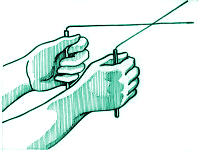We're all aware of our conscious actions. If we want to pick up a pen, for example, we simply think about the action and do it. This is known as volition. It's entirely natural; and it feels entirely natural. There are other actions that we perform however, that are unconscious, instinctive actions: actions performed without volition.
The first category of unconscious action is known as excitomotor actions. These are actions such as breathing, swallowing, and maintaining a heartbeat. The second category is known as sensorimotor actions. These actions are reacting to fright or reflex actions: pulling one's hand away from a heat source before the pain has registered, for example. The common factor in these unconscious actions is that they are instinctive and involuntary.
In 1852, psychologist William B. Carpenter identified a third category of unconscious action: ideomotor action.
What is the ideomotor effect?
Ideomotor actions are unconscious, involuntary motor movements that are performed by a person because of prior expectations, suggestions or preconceptions.
 The classic example is that of dowsing. Dowsers usually hold their rods out in front of them so that they are parallel. When they come across whatever it is they are trying to detect (usually water), the rods will cross over at that point.
The classic example is that of dowsing. Dowsers usually hold their rods out in front of them so that they are parallel. When they come across whatever it is they are trying to detect (usually water), the rods will cross over at that point.
A complete novice who is told that water is beneath the ground at a certain point will find that as they cross the point, their dowsing rods will deflect or cross. This is because they know where the point is and they subconsciously move their hands slightly, which crosses the rods.
The important point to stress is that this is done unconsciously. The person who is crossing the rods does not realise that they are themselves doing it; in fact, it feels as if some external force is acting upon the rods, which makes the experience even more powerful.
This can be shown to be ideomotor action by:
- Blinding the test subject as to where the water is. They perform no better than chance at dowsing water if they don't know where it is beforehand.
- Suggesting to the test subject that water lies in a certain place: perhaps with a false demonstration. It is found that if they believe water to be present, the dowsing rods will cross whether water is there or not. This shows that it is the preconception that causes the effect and not the presence of water.
The same effect is achieved by asking a pendulum to swing north-south to answer "yes" and east-west to answer "no" to a question. It is the subconscious moving of the person's hand that dictates which way the pendulum will swing.
The scope of the ideomotor effect
The ideomotor effect was first recognised as early as the beginning of the 19th century, although Carpenter did not name it as such until 1852. It came to be recognised when scientists looked into 19th century fascinations such as dowsing, pendulums, (non-fraudulent) table tipping in séances, automatic writing, Ouija boards etc. It being a non-paranormal explanation for the results of these practices.
In more modern times, the ideomotor effect has shown itself to be prevalent in medical quackery, especially in the diagnosis of ailments. Radionic devices; chiropractors' rubbing plates; applied kinesiology; and radiesthesia, medical dowsing often with crystals; are examples of where the ideomotor effect is what is actually going on rather than real medical diagnosis.
Another disturbing area where the ideomotor effect shows up is in the pseudoscientific practice of "facilitated communication". This is where people who are otherwise unable to communicate, due to say autism or cerebral palsy, have their hand held over a keyboard by a person known as a "facilitator". When asked questions, the disabled person is now able to communicate with help from the facilitator by typing out answers on the keyboard.
Of course what is really going on is that it's the facilitator who's giving the answers; albeit unconsciously.
Summary
- The ideomotor effect causes small, unconscious motor movements because of the person's expectations, preconceptions or suggestibility.
- The person is not aware that they are causing the movements; therefore they ascribe the movement to an external force or power. The movement feels unnatural.
- The "external forces" perceived are usually thought of as being paranormal in nature.
- The effect is real and therefore can be repeated. This can lead to self-reinforcement of the paranormal explanation of the effect, which can create a belief in some special paranormal ability.
- Once a belief is formed and reinforced, the believer does not usually ever give it up. Dowsers, healers, etc., who continually fail to pass objective, scientific tests do not give up their belief: they tend to make (often fantastical) excuses for their failures rather than accept a rational explanation for their "ability".
Conclusion
The ideomotor effect has been known for over 150 years, yet it is still not a widely known phenomenon. It tends to be used, rightly, as an explanation for dowsing and the Ouija board. Its scope however, is much wider than that and it should be a more widely known explanation for delusions, especially those of medical quacks.
The ideomotor effect is a classic example of how we can be fooled by our senses and ourselves. Many people believe in things because they have experienced them for themselves; they trust in the perceived infallibility of their senses.
The ideomotor effect is just one example of why we should use objective, scientific testing rather than rely on subjective, personal experience to work out what is real and what is not.
